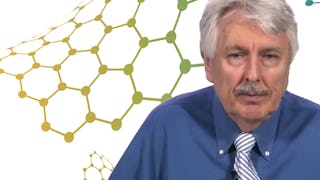This course introduces students to the basic concepts of shaping materials and their impacts on properties and structure. An introduction to the fundamentals of diffusion in a solid follows. We present different types of diffusion mechanisms and their dependence on temperature. The role of dislocation on mechanical properties and how it can be used to strengthen materials will be shown.

Gain next-level skills with Coursera Plus for $199 (regularly $399). Save now.

Shape and Property Control of Metals I & II
This course is part of Materials Science for Technological Application Specialization

Instructor: Terry Alford
1,812 already enrolled
Included with
(20 reviews)
Recommended experience
What you'll learn
Explore Shape and Property Control of Metals.
Skills you'll gain
Details to know

Add to your LinkedIn profile
See how employees at top companies are mastering in-demand skills

Build your subject-matter expertise
- Learn new concepts from industry experts
- Gain a foundational understanding of a subject or tool
- Develop job-relevant skills with hands-on projects
- Earn a shareable career certificate

There are 5 modules in this course
This course introduces students to the basic concepts of shaping materials and their impacts on properties and structure. An introduction to the fundamentals of diffusion in a solid follows. We present different types of diffusion mechanisms and their dependence on temperature. The role of dislocation on mechanical properties and how it can be used to strengthen materials will be shown.
What's included
1 video1 reading
In this module, we explore shape and property control of materials and diffusion of atoms into different materials.
What's included
6 videos8 readings2 discussion prompts
In this module, we explain how physical (e.g. atom size; host atom bond strength) factors affect diffusivity and activation energy.
What's included
3 videos6 readings1 assignment2 discussion prompts
Semiconductor devices require very precise control of the properties of the materials that are used for the devices. In this module, we learn about shape and property control of materials, dislocations, and strengthening mechanisms.
What's included
4 videos8 readings1 discussion prompt
Metal alloys are used for interconnections (and for chip-substrate joins) in semiconductor technology. Strengthening mechanisms are used to enhance the strength and reliability of such interconnects. In this module, we discuss the different kinds of strengthening mechanisms for metals and their alloys.
What's included
4 videos6 readings1 assignment1 peer review1 discussion prompt
Earn a career certificate
Add this credential to your LinkedIn profile, resume, or CV. Share it on social media and in your performance review.
Instructor

Offered by
Explore more from Mechanical Engineering
 Status: Preview
Status: PreviewGeorgia Institute of Technology
 Status: Preview
Status: PreviewGeorgia Institute of Technology
 Status: Free Trial
Status: Free TrialArizona State University
 Status: Free Trial
Status: Free TrialArizona State University
Why people choose Coursera for their career




Learner reviews
20 reviews
- 5 stars
90%
- 4 stars
5%
- 3 stars
5%
- 2 stars
0%
- 1 star
0%
Showing 3 of 20
Reviewed on Dec 26, 2025
Perfectly designed Course. I can augment my teaching with some new insights from this course.

Open new doors with Coursera Plus
Unlimited access to 10,000+ world-class courses, hands-on projects, and job-ready certificate programs - all included in your subscription
Advance your career with an online degree
Earn a degree from world-class universities - 100% online
Join over 3,400 global companies that choose Coursera for Business
Upskill your employees to excel in the digital economy
Frequently asked questions
To access the course materials, assignments and to earn a Certificate, you will need to purchase the Certificate experience when you enroll in a course. You can try a Free Trial instead, or apply for Financial Aid. The course may offer 'Full Course, No Certificate' instead. This option lets you see all course materials, submit required assessments, and get a final grade. This also means that you will not be able to purchase a Certificate experience.
When you enroll in the course, you get access to all of the courses in the Specialization, and you earn a certificate when you complete the work. Your electronic Certificate will be added to your Accomplishments page - from there, you can print your Certificate or add it to your LinkedIn profile.
Yes. In select learning programs, you can apply for financial aid or a scholarship if you can’t afford the enrollment fee. If fin aid or scholarship is available for your learning program selection, you’ll find a link to apply on the description page.
More questions
Financial aid available,
¹ Some assignments in this course are AI-graded. For these assignments, your data will be used in accordance with Coursera's Privacy Notice.

